FIAT 500 2020 Owner handbook (in English)
Manufacturer: FIAT, Model Year: 2020, Model line: 500, Model: FIAT 500 2020Pages: 228, PDF Size: 6.01 MB
Page 141 of 228
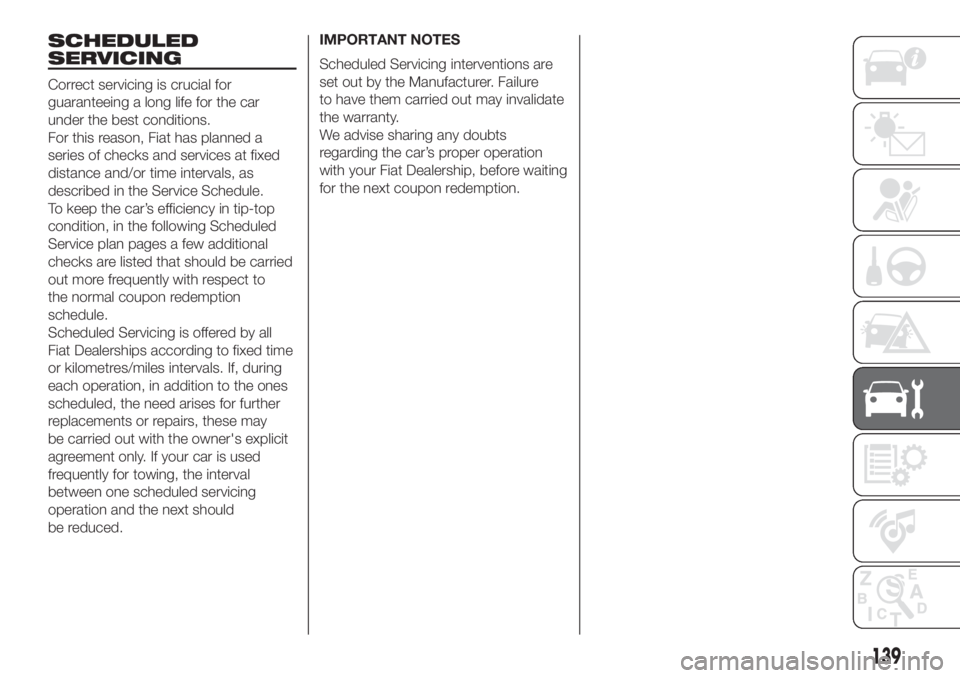
SCHEDULED
SERVICING
Correct servicing is crucial for
guaranteeing a long life for the car
under the best conditions.
For this reason, Fiat has planned a
series of checks and services at fixed
distance and/or time intervals, as
described in the Service Schedule.
To keep the car’s efficiency in tip-top
condition, in the following Scheduled
Service plan pages a few additional
checks are listed that should be carried
out more frequently with respect to
the normal coupon redemption
schedule.
Scheduled Servicing is offered by all
Fiat Dealerships according to fixed time
or kilometres/miles intervals. If, during
each operation, in addition to the ones
scheduled, the need arises for further
replacements or repairs, these may
be carried out with the owner's explicit
agreement only. If your car is used
frequently for towing, the interval
between one scheduled servicing
operation and the next should
be reduced.IMPORTANT NOTES
Scheduled Servicing interventions are
set out by the Manufacturer. Failure
to have them carried out may invalidate
the warranty.
We advise sharing any doubts
regarding the car’s proper operation
with your Fiat Dealership, before waiting
for the next coupon redemption.
139
Page 142 of 228
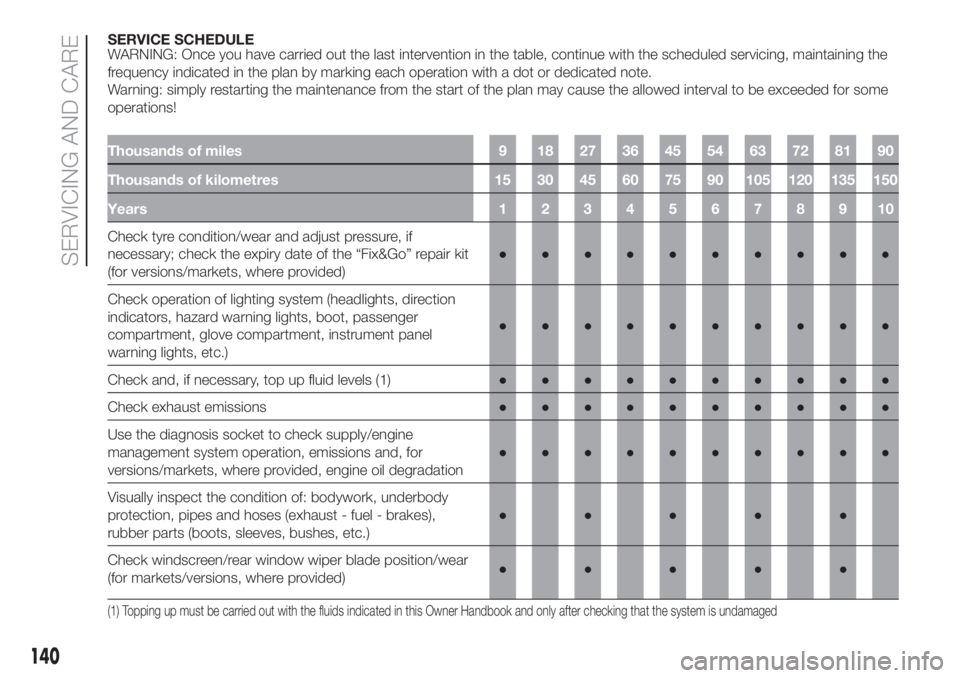
SERVICE SCHEDULE
WARNING: Once you have carried out the last intervention in the table, continue with the scheduled servicing, maintaining the
frequency indicated in the plan by marking each operation with a dot or dedicated note.
Warning: simply restarting the maintenance from the start of the plan may cause the allowed interval to be exceeded for some
operations!
Thousands of miles 9 18 27 36 45 54 63 72 81 90
Thousands of kilometres 15 30 45 60 75 90 105 120 135 150
Years12345678910
Check tyre condition/wear and adjust pressure, if
necessary; check the expiry date of the “Fix&Go” repair kit
(for versions/markets, where provided)●●●●●●●●●●
Check operation of lighting system (headlights, direction
indicators, hazard warning lights, boot, passenger
compartment, glove compartment, instrument panel
warning lights, etc.)●●●●●●●●●●
Check and, if necessary, top up fluid levels (1)●●●●●●●●●●
Check exhaust emissions●●●●●●●●●●
Use the diagnosis socket to check supply/engine
management system operation, emissions and, for
versions/markets, where provided, engine oil degradation●●●●●●●●●●
Visually inspect the condition of: bodywork, underbody
protection, pipes and hoses (exhaust - fuel - brakes),
rubber parts (boots, sleeves, bushes, etc.)●●●●●
Check windscreen/rear window wiper blade position/wear
(for markets/versions, where provided)●●●●●
(1) Topping up must be carried out with the fluids indicated in this Owner Handbook and only after checking that the system is undamaged
140
SERVICING AND CARE
Page 143 of 228
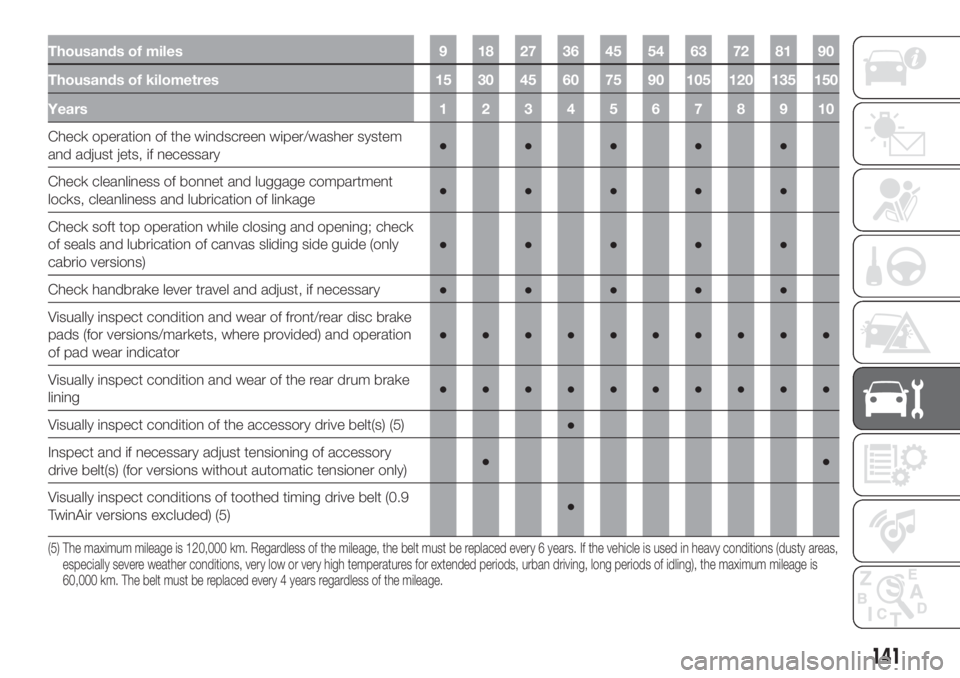
Thousands of miles 9 18 27 36 45 54 63 72 81 90
Thousands of kilometres 15 30 45 60 75 90 105 120 135 150
Years12345678910
Check operation of the windscreen wiper/washer system
and adjust jets, if necessary●●●●●
Check cleanliness of bonnet and luggage compartment
locks, cleanliness and lubrication of linkage●●●●●
Check soft top operation while closing and opening; check
of seals and lubrication of canvas sliding side guide (only
cabrio versions)●●●●●
Check handbrake lever travel and adjust, if necessary●●●●●
Visually inspect condition and wear of front/rear disc brake
pads (for versions/markets, where provided) and operation
of pad wear indicator●●●●●●●●●●
Visually inspect condition and wear of the rear drum brake
lining●●●●●●●●●●
Visually inspect condition of the accessory drive belt(s) (5)●
Inspect and if necessary adjust tensioning of accessory
drive belt(s) (for versions without automatic tensioner only)●●
Visually inspect conditions of toothed timing drive belt (0.9
TwinAir versions excluded) (5)●
(5) The maximum mileage is 120,000 km. Regardless of the mileage, the belt must be replaced every 6 years. If the vehicle is used in heavy conditions (dusty areas,
especially severe weather conditions, very low or very high temperatures for extended periods, urban driving, long periods of idling), the maximum mileage is
60,000 km. The belt must be replaced every 4 years regardless of the mileage.
141
Page 144 of 228
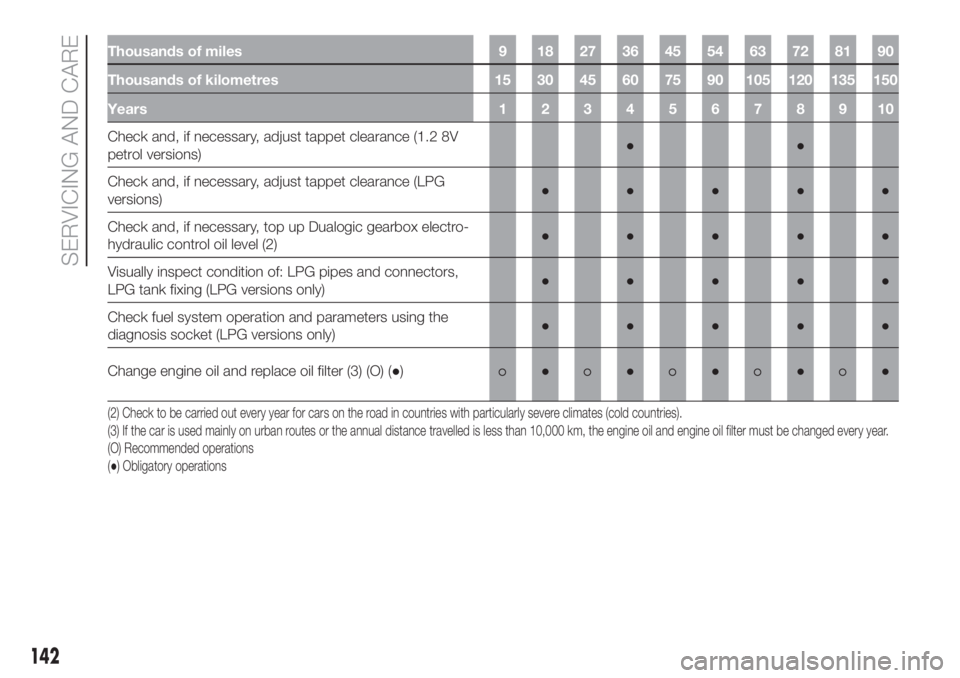
Thousands of miles 9 18 27 36 45 54 63 72 81 90
Thousands of kilometres 15 30 45 60 75 90 105 120 135 150
Years12345678910
Check and, if necessary, adjust tappet clearance (1.2 8V
petrol versions)●●
Check and, if necessary, adjust tappet clearance (LPG
versions)●●●●●
Check and, if necessary, top up Dualogic gearbox electro-
hydraulic control oil level (2)●●●●●
Visually inspect condition of: LPG pipes and connectors,
LPG tank fixing (LPG versions only)●●●●●
Check fuel system operation and parameters using the
diagnosis socket (LPG versions only)●●●●●
Change engine oil and replace oil filter (3) (O) (●)
●●●●●
(2) Check to be carried out every year for cars on the road in countries with particularly severe climates (cold countries).
(3) If the car is used mainly on urban routes or the annual distance travelled is less than 10,000 km, the engine oil and engine oil filter must be changed every year.
(O) Recommended operations
(●) Obligatory operations
142
SERVICING AND CARE
Page 145 of 228
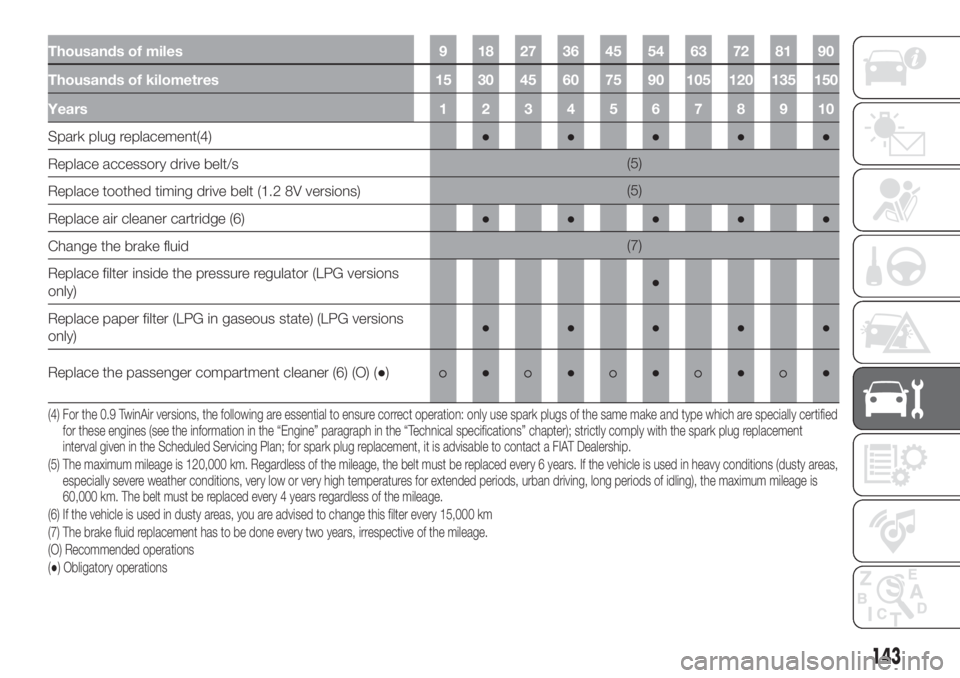
Thousands of miles 9 18 27 36 45 54 63 72 81 90
Thousands of kilometres 15 30 45 60 75 90 105 120 135 150
Years12345678910
Spark plug replacement(4)●●●●●
Replace accessory drive belt/s(5)
Replace toothed timing drive belt (1.2 8V versions)(5)
Replace air cleaner cartridge (6)●●●●●
Change the brake fluid(7)
Replace filter inside the pressure regulator (LPG versions
only)●
Replace paper filter (LPG in gaseous state) (LPG versions
only)●●●●●
Replace the passenger compartment cleaner (6) (O) (●)
●●●●●
(4) For the 0.9 TwinAir versions, the following are essential to ensure correct operation: only use spark plugs of the same make and type which are specially certified
for these engines (see the information in the “Engine” paragraph in the “Technical specifications” chapter); strictly comply with the spark plug replacement
interval given in the Scheduled Servicing Plan; for spark plug replacement, it is advisable to contact a FIAT Dealership.
(5) The maximum mileage is 120,000 km. Regardless of the mileage, the belt must be replaced every 6 years. If the vehicle is used in heavy conditions (dusty areas,
especially severe weather conditions, very low or very high temperatures for extended periods, urban driving, long periods of idling), the maximum mileage is
60,000 km. The belt must be replaced every 4 years regardless of the mileage.
(6) If the vehicle is used in dusty areas, you are advised to change this filter every 15,000 km
(7) The brake fluid replacement has to be done every two years, irrespective of the mileage.
(O) Recommended operations
(●) Obligatory operations
143
Page 146 of 228
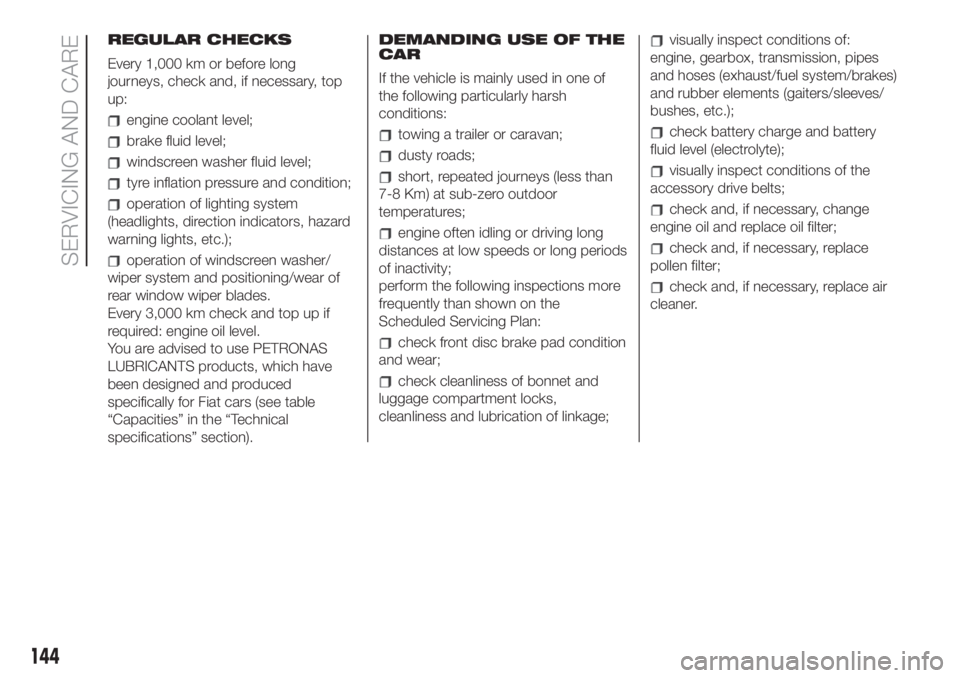
REGULAR CHECKS
Every 1,000 km or before long
journeys, check and, if necessary, top
up:
engine coolant level;
brake fluid level;
windscreen washer fluid level;
tyre inflation pressure and condition;
operation of lighting system
(headlights, direction indicators, hazard
warning lights, etc.);
operation of windscreen washer/
wiper system and positioning/wear of
rear window wiper blades.
Every 3,000 km check and top up if
required: engine oil level.
You are advised to use PETRONAS
LUBRICANTS products, which have
been designed and produced
specifically for Fiat cars (see table
“Capacities” in the “Technical
specifications” section).DEMANDING USE OF THE
CAR
If the vehicle is mainly used in one of
the following particularly harsh
conditions:
towing a trailer or caravan;
dusty roads;
short, repeated journeys (less than
7-8 Km) at sub-zero outdoor
temperatures;
engine often idling or driving long
distances at low speeds or long periods
of inactivity;
perform the following inspections more
frequently than shown on the
Scheduled Servicing Plan:
check front disc brake pad condition
and wear;
check cleanliness of bonnet and
luggage compartment locks,
cleanliness and lubrication of linkage;
visually inspect conditions of:
engine, gearbox, transmission, pipes
and hoses (exhaust/fuel system/brakes)
and rubber elements (gaiters/sleeves/
bushes, etc.);
check battery charge and battery
fluid level (electrolyte);
visually inspect conditions of the
accessory drive belts;
check and, if necessary, change
engine oil and replace oil filter;
check and, if necessary, replace
pollen filter;
check and, if necessary, replace air
cleaner.
144
SERVICING AND CARE
Page 147 of 228
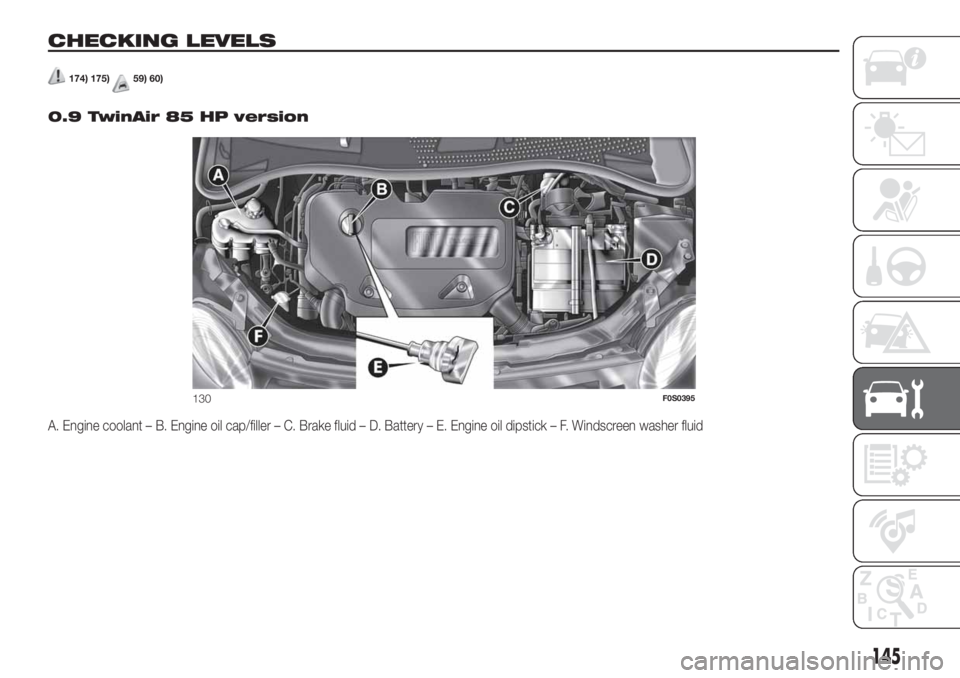
CHECKING LEVELS
174) 175)59) 60)
.
0.9 TwinAir 85 HP version
A. Engine coolant – B. Engine oil cap/filler – C. Brake fluid – D. Battery – E. Engine oil dipstick – F. Windscreen washer fluid
130F0S0395
145
Page 148 of 228
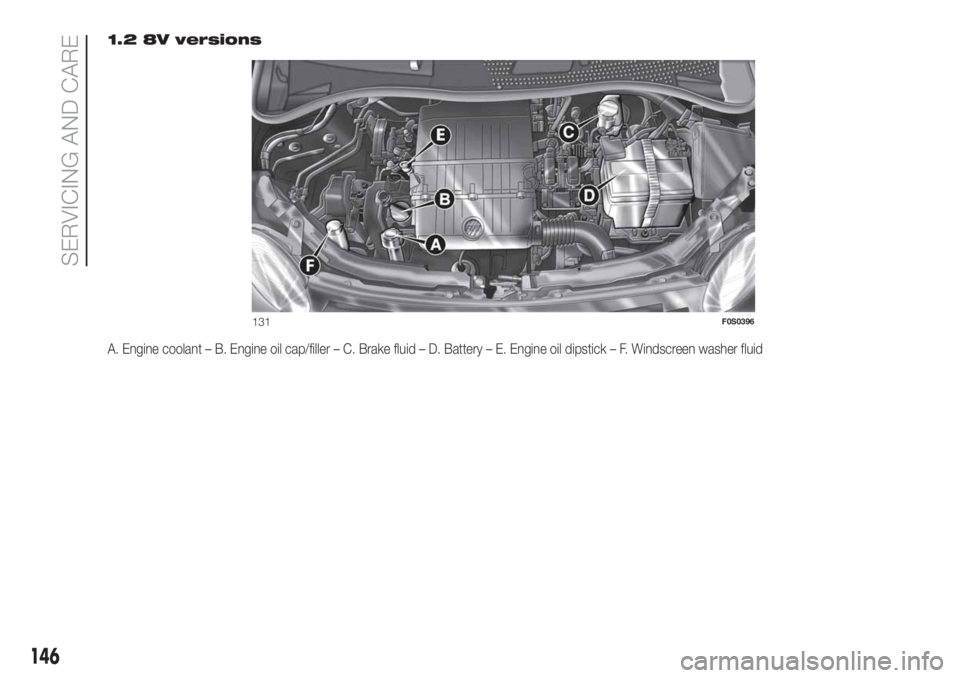
1.2 8V versions
A. Engine coolant – B. Engine oil cap/filler – C. Brake fluid – D. Battery – E. Engine oil dipstick – F. Windscreen washer fluid
131F0S0396
146
SERVICING AND CARE
Page 149 of 228
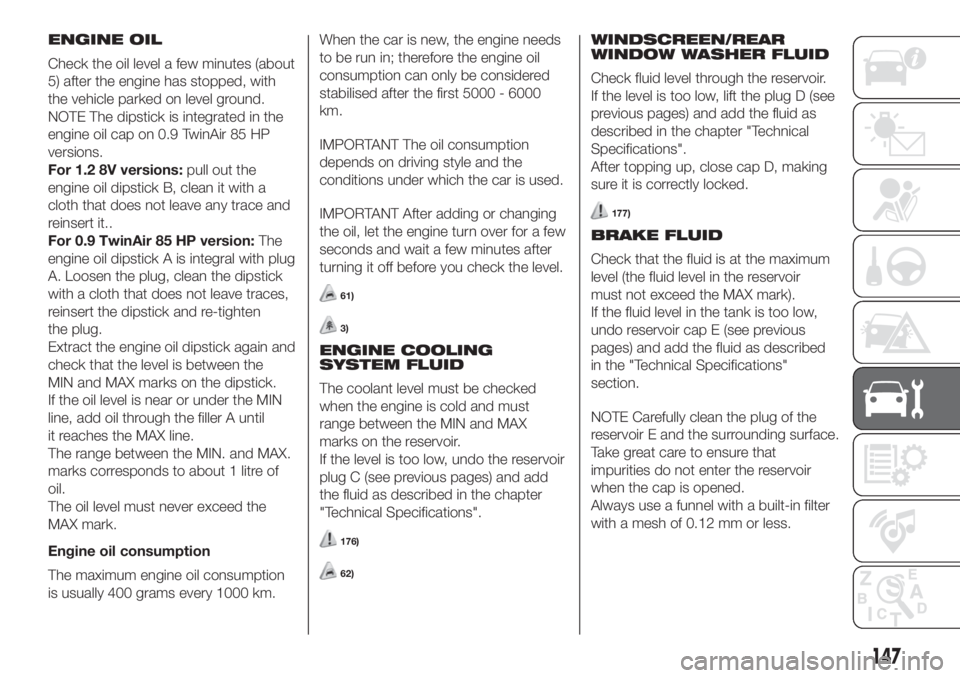
ENGINE OIL
Check the oil level a few minutes (about
5) after the engine has stopped, with
the vehicle parked on level ground.
NOTE The dipstick is integrated in the
engine oil cap on 0.9 TwinAir 85 HP
versions.
For 1.2 8V versions:pull out the
engine oil dipstick B, clean it with a
cloth that does not leave any trace and
reinsert it..
For 0.9 TwinAir 85 HP version:The
engine oil dipstick A is integral with plug
A. Loosen the plug, clean the dipstick
with a cloth that does not leave traces,
reinsert the dipstick and re-tighten
the plug.
Extract the engine oil dipstick again and
check that the level is between the
MIN and MAX marks on the dipstick.
If the oil level is near or under the MIN
line, add oil through the filler A until
it reaches the MAX line.
The range between the MIN. and MAX.
marks corresponds to about 1 litre of
oil.
The oil level must never exceed the
MAX mark.
Engine oil consumption
The maximum engine oil consumption
is usually 400 grams every 1000 km.When the car is new, the engine needs
to be run in; therefore the engine oil
consumption can only be considered
stabilised after the first 5000 - 6000
km.
IMPORTANT The oil consumption
depends on driving style and the
conditions under which the car is used.
IMPORTANT After adding or changing
the oil, let the engine turn over for a few
seconds and wait a few minutes after
turning it off before you check the level.
61)
3)
ENGINE COOLING
SYSTEM FLUID
The coolant level must be checked
when the engine is cold and must
range between the MIN and MAX
marks on the reservoir.
If the level is too low, undo the reservoir
plug C (see previous pages) and add
the fluid as described in the chapter
"Technical Specifications".
176)
62)
WINDSCREEN/REAR
WINDOW WASHER FLUID
Check fluid level through the reservoir.
If the level is too low, lift the plug D (see
previous pages) and add the fluid as
described in the chapter "Technical
Specifications".
After topping up, close cap D, making
sure it is correctly locked.
177)
BRAKE FLUID
Check that the fluid is at the maximum
level (the fluid level in the reservoir
must not exceed the MAX mark).
If the fluid level in the tank is too low,
undo reservoir cap E (see previous
pages) and add the fluid as described
in the "Technical Specifications"
section.
NOTE Carefully clean the plug of the
reservoir E and the surrounding surface.
Take great care to ensure that
impurities do not enter the reservoir
when the cap is opened.
Always use a funnel with a built-in filter
with a mesh of 0.12 mm or less.
147
Page 150 of 228
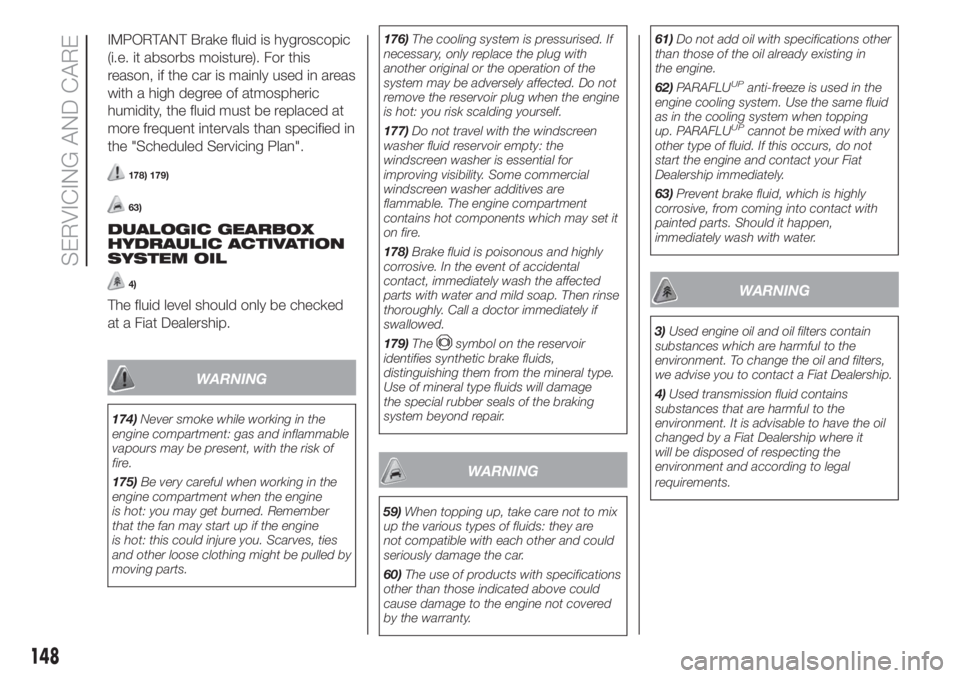
IMPORTANT Brake fluid is hygroscopic
(i.e. it absorbs moisture). For this
reason, if the car is mainly used in areas
with a high degree of atmospheric
humidity, the fluid must be replaced at
more frequent intervals than specified in
the "Scheduled Servicing Plan".
178) 179)
63)
DUALOGIC GEARBOX
HYDRAULIC ACTIVATION
SYSTEM OIL
4)
The fluid level should only be checked
at a Fiat Dealership.
WARNING
174)Never smoke while working in the
engine compartment: gas and inflammable
vapours may be present, with the risk of
fire.
175)Be very careful when working in the
engine compartment when the engine
is hot: you may get burned. Remember
that the fan may start up if the engine
is hot: this could injure you. Scarves, ties
and other loose clothing might be pulled by
moving parts.176)The cooling system is pressurised. If
necessary, only replace the plug with
another original or the operation of the
system may be adversely affected. Do not
remove the reservoir plug when the engine
is hot: you risk scalding yourself.
177)Do not travel with the windscreen
washer fluid reservoir empty: the
windscreen washer is essential for
improving visibility. Some commercial
windscreen washer additives are
flammable. The engine compartment
contains hot components which may set it
on fire.
178)Brake fluid is poisonous and highly
corrosive. In the event of accidental
contact, immediately wash the affected
parts with water and mild soap. Then rinse
thoroughly. Call a doctor immediately if
swallowed.
179)The
symbol on the reservoir
identifies synthetic brake fluids,
distinguishing them from the mineral type.
Use of mineral type fluids will damage
the special rubber seals of the braking
system beyond repair.
WARNING
59)When topping up, take care not to mix
up the various types of fluids: they are
not compatible with each other and could
seriously damage the car.
60)The use of products with specifications
other than those indicated above could
cause damage to the engine not covered
by the warranty.61)Do not add oil with specifications other
than those of the oil already existing in
the engine.
62)PARAFLU
UPanti-freeze is used in the
engine cooling system. Use the same fluid
as in the cooling system when topping
up. PARAFLU
UPcannot be mixed with any
other type of fluid. If this occurs, do not
start the engine and contact your Fiat
Dealership immediately.
63)Prevent brake fluid, which is highly
corrosive, from coming into contact with
painted parts. Should it happen,
immediately wash with water.
WARNING
3)Used engine oil and oil filters contain
substances which are harmful to the
environment. To change the oil and filters,
we advise you to contact a Fiat Dealership.
4)Used transmission fluid contains
substances that are harmful to the
environment. It is advisable to have the oil
changed by a Fiat Dealership where it
will be disposed of respecting the
environment and according to legal
requirements.
148
SERVICING AND CARE